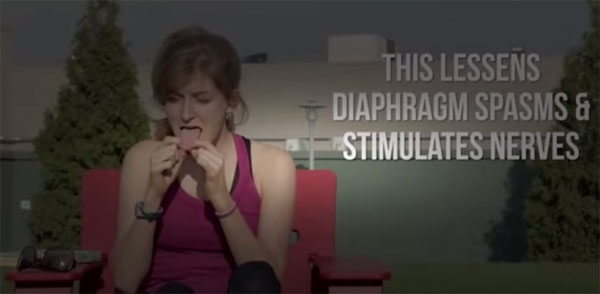Simple tips to cure hiccups, nasal congestion very effectively
Some minor problems such as nasal congestion, hiccups, sneezing or teary tears are not dangerous, but create discomfort and inconvenience for the affected person. With just a few simple steps, we can easily overcome these troubles.
The method of hiccup curing, rapid nasal clearance
Decongestants
If you have a stuffy nose, push two fingers between your eyebrows and push your tongue up to reach the roof of your mouth. This approach is believed to help block congestion through the transfer of vomer.
Stop hiccups

Snapshot from video.
Ordinary hiccups are not dangerous but cause discomfort and inconvenience for the infected person. If you have hiccups, try drinking water while covering your ears with your hands. If hiccups are not over, stretch your tongue out with your hand. This will reduce episodes of diaphragmatic contractions and stimulate nerves.
Stop tearing
If your eyes don't stop crying, look up at the ceiling and hold your breath, then slowly exhale. You can also squeeze the bridge of the nose near the middle of the eyes. This has the effect of preventing tears from flowing from your lacrimal glands.
Terminate or cause sneezing
Looking at the bright light, such as the sun, will make you sneeze. Conversely, if you want to stop sneezing, squeeze the bridge of your nose or / and use your tongue to tickle your mouth. However, the advice of experts is, it is best to let sneeze occur naturally to avoid potential damage.
- Small tips from hiccups right away
- Good tips for relieving cough immediately
- Having a stuffy nose when you get the flu, is it better to go outside or swallow the stomach?
- Why hiccup?
- How to cure hiccups immediately at home
- New equipment for effective hiccups
- Video: The process of forming hiccups in humans.
- Tips or cure for flu without taking antibiotics
- Why should I eat chicken soup when I'm sick?
- 11 tips to remove foot odor effectively
- The secret to staying healthy during the cold season
- Simple way to wash nasal respiratory disease
 Green tea cleans teeth better than mouthwash?
Green tea cleans teeth better than mouthwash? Death kiss: This is why you should not let anyone kiss your baby's lips
Death kiss: This is why you should not let anyone kiss your baby's lips What is salmonellosis?
What is salmonellosis? Caution should be exercised when using aloe vera through eating and drinking
Caution should be exercised when using aloe vera through eating and drinking Scientists explain why we hiccup
Scientists explain why we hiccup  How to cure hiccups immediately at home
How to cure hiccups immediately at home  Why hiccup?
Why hiccup?  Husband was beaten because his wife hiccuped
Husband was beaten because his wife hiccuped  Video: The process of forming hiccups in humans.
Video: The process of forming hiccups in humans.  Small tips from hiccups right away
Small tips from hiccups right away 